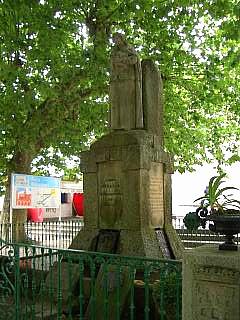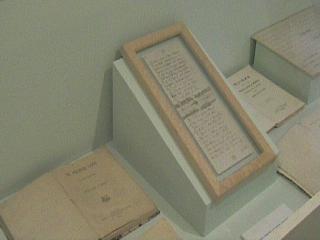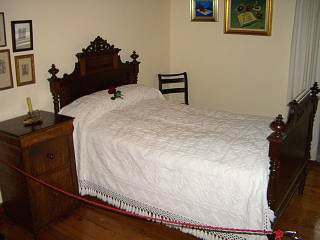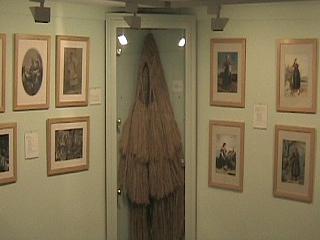Padron and Rosalia de Castro

The museum of "Rosalia de Castro"
Everywhere you travel in Galicia you will see statues, busts, gardens and buildings dedicated to Rosalia de Castro, a famous poet and author. Castro battled with personal adversity throughout her life, but left a literary legacy that is second to none in Spain.
Left is a photo of the Rosalia de Castro monument on the "Espolon Promenade" in the old town of Padron. A bust of another famous writer, "Cela", is at the opposite end of the park.
Where is Rosalia de Castros's museum is located?
If you travel a short distance from the center of Padron (it can be walked), you can visit the former house and now museum of Galicia's most celebrated literary artist, "Rosalia Castro". This museum is said to be the most visited in all of Galicia. You can see it below and to the right.

The house is well sign posted and is also opposite the railway station. The cost of entry is a couple of Euros per head and that includes the tour which lasts about 15 minutes. The tour is in Spanish, but our guide made a point of speaking to us at the end of each rooms "mini lecture" in English and was extremely helpful.
So what will you see?
The museum has two main offerings. The first is the house and its grounds, parts of which have been retained exactly as they were when Castro lived there. The second is a combination of manuscripts and commemorative items that feature Rosalia de Castro.
Who was Rosalia de Castro?
Firstly, we were unable to bring back any written information about Rosalia de Castro, so what follows is a general summary based on memory. Please forgive any errors.
Rosalia de Castro was born illegitimately as María Resalía Rita in 1837 with a Catholic priest as a father. Since priests are not allowed to marry (or consort), her parentage was not declared and she was consequently born fatherless and into shame. Either her mother died during or shortly after childbirth or she was forced to give up her daughter, making Castro an orphan (I cannot remember which).
Castro was subsequently brought up by an "aunt" in what we were told was abstract poverty, but she was intelligent, and had a quest for knowledge and research.
When she entered adulthood she was somehow able to go to college. This was very unusual at the time since both financial and sexist restrictions would appear to make this unlikely. The suggestion is that her biological father (the priest) may have provided financial support and used his influence to assist in her education.
Although Castro had the worst of starts to life, by the age of 12 she had commenced writing and by 17 she was known as quot;Liceo de San Agustín".
She married a scholar in 1855 and they had no less than seven children, but the tragedies continued and she died of cancer at 48 years of age. Worst still, if this were possible, she out lived all seven of her children, none of whom produced an heir.
During her lifetime she was published on only three occasions, all at the behest of her husband. When she knew she was dieing, she asked that all her unpublished manuscripts be destroyed, but her husband felt honour bound to get them published and so her legacy was created. The most famous of her works is quot; En las orillas del Sar quot;, which is considered a Castilian masterpiece.
Museum contents
The museum has three rooms that offer displays and these include some of
 Rosalia de Castro's original manuscripts along with first publications.
Rosalia de Castro's original manuscripts along with first publications.
To the right is one of Rosalia de Castro's poems, written in her own hand and in the display cabinet around it are first editions of some of her books.
There is also a significant collection of commemorative memorabilia including coins and stamps along with some other items that reflect the period of her life.
The remainder of the house is as it would have been when Castro actually lived there and you can see the desk and chair at which see worked along with the bed in which she slept.
The bed always has a red rose or camellia on the pillow as a mark of respect. These were Rosalia de Castro's two favourite flowers and both grew in her garden.

The house itself now appears quite grand, but we were told that this was not the case in her day. You are free to take photos and videos in the house and garden.
Left, the bed in which Castro slept with the flower on the pillow.
Below, here is one of the more unusual exhibits at the museum.
 It is a rain coat of the period and is made entirely of straw.
It is a rain coat of the period and is made entirely of straw.
Other items on display include art work by Castro's children.
More on Rosalia de Castro
To find out more about Rosalia de Castro, including English translations of 11 of her poems, take a look at this Rosalia de castro website by Eduardo Freire Canosa.

